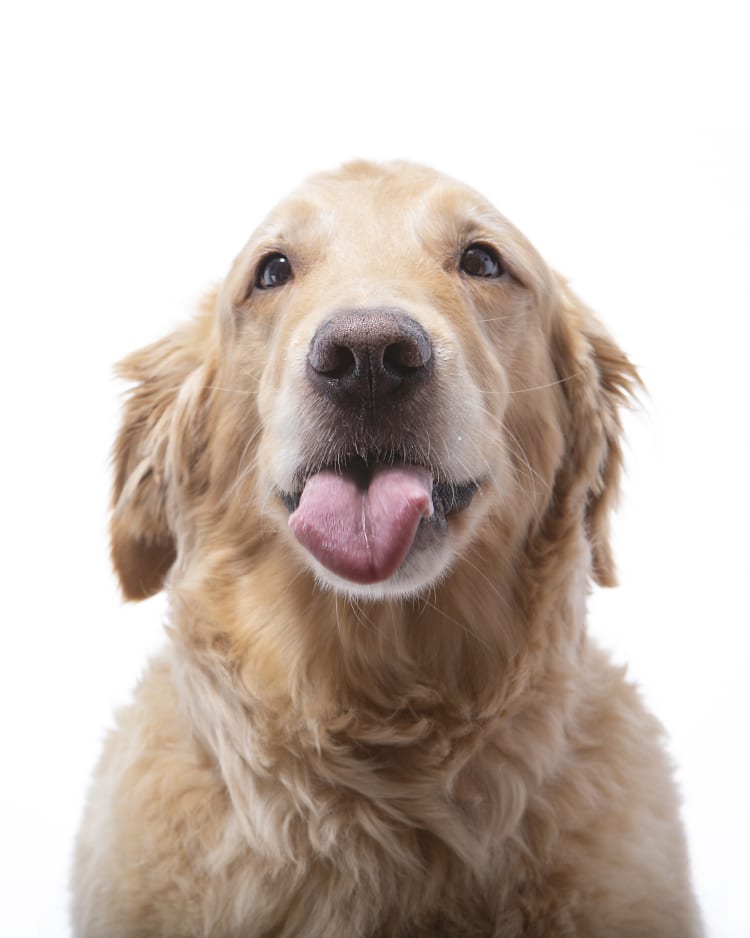Written by J.B. Shepard, professional pet photographer and founder of the Puptrait Studio.
One of the toughest smells to get out of fabric is pet urine. And, as a studio that exclusively photographs dog portraits, we’ve been forced to learn a thing or two about cleaning up pet urine, eliminating pet odors and discouraging future markings.
As accidents are bound to happen with most pets, we thought it might be handy to share some of our pet urine do’s and don’ts, as well as a brief and easy to understand technical explanation of the science backing these helpful pet lifehacks.
Please note the Puptrait Studio may collect a share of sales or other compensation from the links on this page. Prices and links are accurate and items in stock as of time of publication.
Do NOT clean pet urine with Hydrogen Peroxide
You’ll notice below that we do not recommend using hydrogen peroxide to clean up pet stains. The reason for this is we do not want to accidentally trigger a chemical reaction that will damage our surface or release potentially harmful gases.
You might remember the classic volcano “science experiment” from elementary school or chemistry class, mixing vinegar or hydrogen peroxide with baking soda. While the process demonstrated by these paper mache volcanos do a great job demonstrating ph and endothermic reactions, and may even look or sound like they are “working”, when cleaning dog urine these methods are not often as effective or safe as they may appear.
Everyone pees, but not all pee is the same
Urine is fairly inconsistent in many ways. There are a lot of different chemicals and compounds that can be found in urine depending on various factors, such as the health and diet of your dog. Many of these differences have a lot to do with why we don’t recommend using hydrogen peroxide to eliminate urine messes and stains.
Just neutralizing PH isn’t enough
These variables can vary to such a degree that it can actually impact the PH of your pet’s urine. Your dog’s urine may be a weak acid or a weak base – so you can’t reliably count on a ph based reaction. More over, if a reaction is triggered you really have no idea what by products you will be generating or to what degree. It may have no reaction, it might cause an endothermic reaction and literally burn the material you are intending to clean or generate toxic ammonia gas fumes that could potentially harm you or your pets.
But two components can be found consistently in most urine — ammonia and urea salts.
Window cleaner is a surprisingly effective pet urine cleaner
By using an ammonia based cleaning spray, such as Windex, we are able to disinfect the impacted area and neutralize much of the ammonia and urea salts. Effectively converting theses chemicals into easy to vacuum and relatively inert (read: less smelly) compounds such as ammonia salts (smelling salts), carbon dioxide, and sodium bicarbonate (baking soda) through a chemical mechanism called the Solvay Process.
What is the Solvay Process?
We’ll skip the actual formulation of the process as this is a dog blog and not a chemistry or pop science blog. But in short, the Solvay Process is how most baking soda is made on an industrial scale. This industrial process for producing sodium bicarbonate starts by first passing ammonia bubbles through salt water. Then by passing carbon dioxide through this now ammoniated brine produces sodium bicarbonate (baking soda) and NH4Cl (ammonia salts or more commonly known as “smelling salts“).
Ammonia salts are water soluble, which makes them simple to remove from most hard surfaces and the fabrics typically used to upholster furniture or carpet floors. And, sodium bicarbonate tends to neutralizes fatty acids, which would include most of the biological odor sources in your pet’s urine – including most pheromones and by products of fermented animal fats.
That said, materials and results do vary. With any deep cleaning technique, please be sure to test in an inconspicuous area first before attempting to remove any large stains or those featured in more prominent locations.
Ammonia salts sound scary, but are not the same as ammonia gas
As ammonia salts release little ammonia gas (unlike mixing ammonia and vinegar or hydrogen-peroxide), are relatively inert and are highly soluble in water, making for a much easier and safer cleanup when dealing with pet urine.
How does baking soda eliminate pet odors?
Sodium bicarbonate won’t eliminate all odors, but it will bond with more volatile fatty acids (a common byproduct of many spoiled foods and fermented plant oils / animal fats ) and convert these acids into more inert and less smelly compounds. This is why storing an open box of baking soda in a fridge or freeze is such a common household practice.
As many of the biological sources of odor contained in urine are fatty acids, such as metabolized proteins and fats, many pheromones, and sex hormones, baking soda can be very effective at eliminating urine based pet odors and can help minimize the risk of pets returning to mark the same spot. Which is handy if you host a lot of pet friends, foster animals or operate a dog friendly photography studio.
So, you can probably appreciate why a cleaning technique that produces baking soda as a natural byproduct of cleaning, might be a helpful alternative to the trace amounts of mustard gas that hydrogen peroxide based techniques might likely produce instead.
How to clean pet urine like a professional
There are a lot of pet products on the market toting themselves as all-in-one solutions. While many work surprisingly well in a pinch (responding quickly is always the best option), I’ve never found one that works quite as well as our tried-and-true multi-step method.
Items & cleaning products you will need:
- 2 x high velocity fans
- Windex (or any ammonia based window cleaner)
- Baking Soda mixed into paste (in a plastic bowl, mix 2 parts baking soda with 1 part water)
- Dry baking soda powder
- Paper Towels
- a Wet-Vac
- a stiff bristle brush
Time needed: 12 hours
Please note, as with any solvent based cleaning product, be sure to test your spray on a less conspicuous area, as an ammonia based spray may damage or discolor the material you are intending to clean.
- Ventilate the room
Open a window and use a fan to redirect air out of your home. Optimally, the fan should be pulling air in from another room towards the mess and out the window. If you have two fans, put the second one in the window blowing air out.
Continue ventilating the room through all of the following steps. Proper ventilation will help contain any free floating particles and scents, help in the drying process, and will help dissipate any toxic fumes that may arise from cleaning. - Remove all solid mess or pooling fluids
If you’re also dealing with dog poop or vomit, make sure anything that can be picked up gets picked up and disposed of safely. If there is a large amount of puddling, make sure that is soaked up as well before proceeding.
- Spray the area with Windex
Spray the soiled area liberally with Windex until it is noticeably moist to the touch.
- Pad dry with paper towels
The area does not need to be bone dry, however you should not be able to “ring-out” any fluid or bubbles when pressing into the carpet.
- Spray again and repeat padding
Rinse and repeat. Enough said.
- Apply baking soda paste
Pack the baking soda paste you prepared earlier deep into the impacted area.
- Sprinkle even more baking soda
Rugs and carpets are virtual pet odor magnets – even on less messy days. So, if you’re going to have to clean up the spot mess, you may as well clean / deodorize the surrounding area while you are at it. Liberally sprinkle baking soda powder around the soiled area and across the entirety of your carpet or rug.
- Let the mixture dry overnight
We find it best to let the mixture dry for several hours, typically over night. Again, the mixture doesn’t need to be bone dry. It just needs a chance to set and bond with the mess.
- Vacuum the area
Remove the caked on paste. With any luck the bulk of your mess and odors will be removed with the paste.
- Reapply the baking soda paste and brush
Apply paste liberally to the impacted and brush the area. For smaller spots, use a hand brush with a down, in and up motion – like you are whisking an egg. For larger soiled areas, use a push brush, scrubbing the mess towards the edge of the area.
Both of these techniques should help pull the mess up and out of the fabric, rather than grind it deeper into your rug, carpet or couch.
Act quickly to reduce the risk of stains and odors
We hope you never have to use our tips to cleanup dog urine in your own home. But if you do, we hope that you found our clean up and pet odor eliminating advice helpful. Remember, the faster you can respond to a house training accident the easier it will be to minimize the risk of long term stain or odor damage.
Which is why we strongly recommend stocking up on cleaning supplies before an incident happens. It’s always better to be prepared and not need to clean, then to be forced to deal with a puddle of urine unexpectedly and not be ready.
The Puptrait Studio may collect a share of sales or other compensation from the links on this page. Prices are accurate and items in stock as of time of publication.
About the author:J.B. Shepard, is a professional pet photographer, dog advocate, and founder of the Puptrait Studio. J.B. lives in Hampden, with his wife and two rescue dogs — George (a Boggle – Beagle / Boxer mix) and Lucky (a Jack Russell Terrier).


